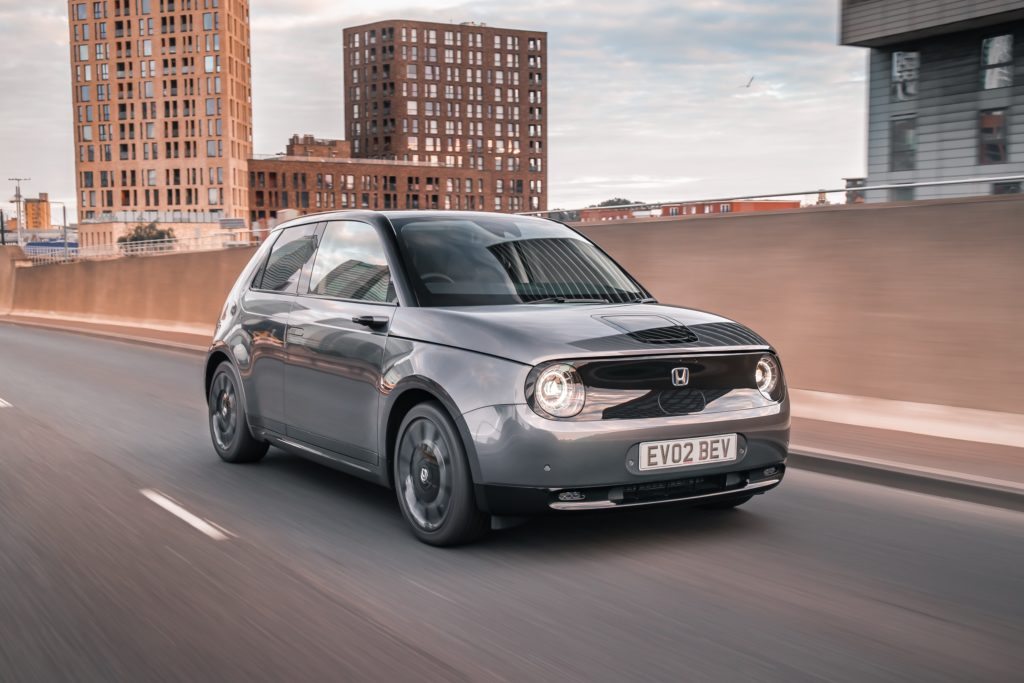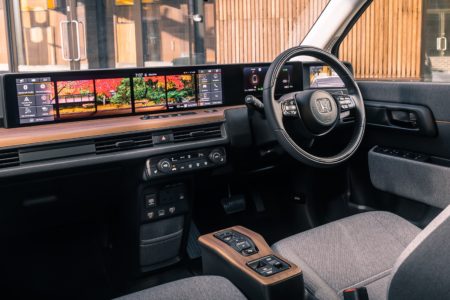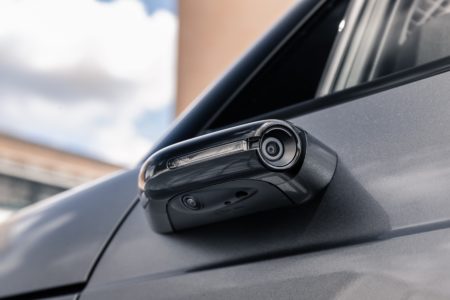Inside the Honda e
by Ailsa Harvey · 14/12/2020
Discover how battery power is transforming driving as we look inside Honda's first fully-electric vehicle

In today’s world we always have somewhere to be, and many of us rely on cars to get us there. These vehicles have been around since the late 1800s, and they are on their own evolutionary journey. From the clunky early models that only needed to transport people from A to B to be deemed successful, to today’s more environmentally friendly vehicles, car companies are always looking towards the next best thing. One of their main focuses is removing the old engines of these vehicles and providing sustainable but desirable electric cars.
Car company Honda’s solution to an electric future is the Honda e. As Honda’s first fully electric launch, it’s aimed to suit a city commute, with a maximum travel range of 220 kilometres, or 137 miles, per charge. Tackling an area most impacted by traffic-heavy roads, new electric cars like this could be a progression towards healthier cities and quieter streets.
Digital dashboard
The dashboard is filled with electronic technology that’s powered by the car’s battery. It includes five screens to display apps and other features that aid driving. The car can also be connected to a smartphone to display music apps and contacts for in-car calls. Videos and films can only be viewed when stationary. A screen near the driver and one by the passenger can be switched so that tools for navigation and those for entertainment are nearest to the person benefitting from them.

Battery power
The 35.5 kWh lithium-ion battery keeps the car running on electricity up to 137 miles on a single charge. To optimise performance it has a thermal management system which adapts to heat or cool the battery in fluctuating conditions.
Handling
Installed to improve handling, the car’s power is also sent to the back wheels. The rear-wheel drive helps to make driving feel more balanced and powerful. As more electric cars appear on the market, we could see the end of front-wheel drive. Their motors are relatively small compared to the engines of gas-powered cars, making them easier to mount at the front, back or both ends of the vehicle. In the Honda e, power at the rear improves the electric driving experience. Without having a heavy engine near the front, the back is where the weight of the car is pushed to during acceleration.
For driving around the tight corners of cityscapes, the Honda e is designed with a 50:50 weight distribution and a low centre of gravity, placed 50 centimetres from the ground. The strong-but-lightweight chassis also comes with independent suspension. At its edges, protective panels protect the car’s battery from any side collisions.
Cameras for mirrors
Wing mirrors are replaced with sleek and subtle cameras. The goings on from all around the vehicle can be monitored in front of you. These cameras stream live video footage onto screens at the edges of the dashboard and are positioned to minimise any blind spots. By having them inside the car rather than behind the windows, views are clear in all conditions. If cars approach too close from the sides, the camera footage will display distance lines to better inform you of how much space lies between the vehicles. When darkness falls, the Honda e’s cameras adapt to night vision, maximising your visibility of the roads. They also feature glare resistance, preventing headlights behind you from limiting your vision.

Visualising power
Just as a petrol- or diesel-powered car displays how much fuel is left in the tank, behind the steering wheel a screen shows what percentage of charge is left in the battery. This gauge will tell you how many miles you have left and will alert you with visual warnings when it is getting low. When you receive this alert, there is still enough time to drive to the nearest charging point.
Parking assistance
Have you ever reversed into a space and needed your passenger to get out and guide you as you park? Taking over this role in the Honda e is the Parking Pilot. The sonar and camera technology can be used to better inform you of nearby objects and alerts you when you drive too close. On the display, an aerial view diagram of the car shows your position relative to surrounding objects. This helps the driver to view all the space around them at once, helping them park safely and with confidence.
Another option is to let the car park itself. By pressing the parking button, the car’s four cameras and 12 sonar sensors scan the area for a suitable space. The cameras look for white parking lines on the road, while the sonar sensors check that there are no obstructions. The car completes this manoeuvre without the driver touching the steering wheel, gears, accelerator or brake.
This article was originally published in How It Works issue 143
For more science and technology articles, get your Christmas subscription to How It Works for as little as £7.15 on our website now. If you have a tablet or smartphone, you can also download the digital version onto your iOS or Android device. To make sure you never miss an issue of How It Works magazine, subscribe today!






